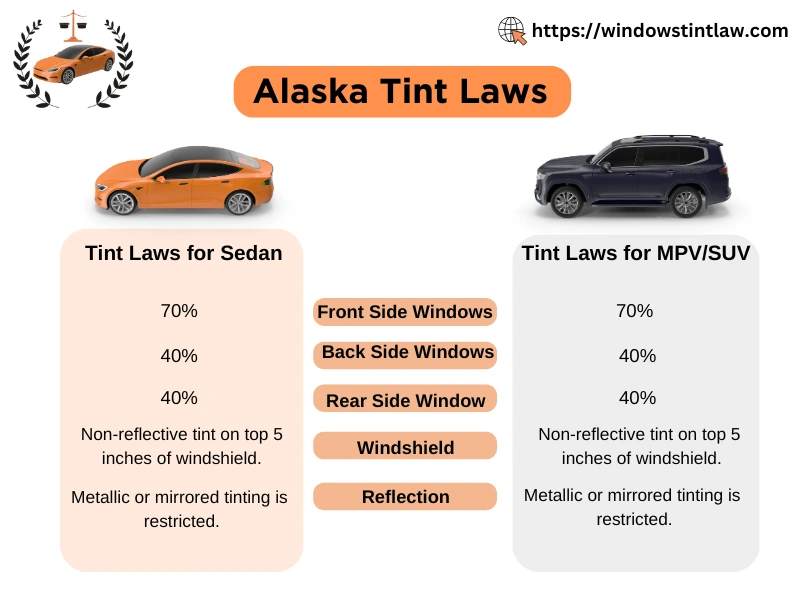Alaska window tinting laws were legislated in 1994 for the safety of drivers and passengers on roads and highways. Vehicle owners must follow the limitations of Tint regulations to avoid Tint tickets or fines. Repeated violation of tinting rules can may lead to serious legal issues.
The sun screening materials on the front side windows must allow 70% of the Visible Light Transmission through the window glass. While the back side windows and rear window must pass minimum 40% of the Visible Light. Moreover, Non reflective tinting materials are allowed to install on the front windshield, with a limit of top 5 inches of the screen.
Automobile tints offer multiple benefits for Vehicle owners, but on the other sides disobeying the legal tint limits can cause issue. Hence, it is recommended to follow the rules before applying the tinting films on the vehicle windows.
Overview of Alaska Tint Laws
Any person may not drive the vehicle on highways, roads and streets with mirrored tinting materials installed on windows. Moreover, the aftermarket tint applied to motor vehicles must comply with the requirements illustrated below:

Darkest Legal Tint in Alaska
The darkest legal tint percentages for Sedan and SUV or MPV type vehicles are mentioned in the below tables:
Legal Tint Darkness For Cars
Vehicles classified in Sedan Category must follow the below limits for Tint darkness and Luminous reflection. Additionally the allowed tint colors are also indicated in the table below.
| State | Front Side Windows | Back Side Windows | Rear Window | Windshield | Tint Reflection | Tint Colors |
| Alaska | 70% VLT | 40% VLT | 40% VLT | Non-reflective tint on top 5 inches of windshield. | Must not metallic or mirrored type of tint. | Green, Grey, Bronze and neutral smoke color tints are allowed. |
Legal Tint Darkness For SUVs or MPVs
SUVs, MPVs and Trucks type vehicles operated in state of Alaska must follow the below tinting requirements to avoid Violations of Tinting regulations.
| State | Front Side Windows | Back Side Windows | Rear Window | Windshield | Tint Reflection | Tint Colors |
| Alaska | 70% VLT | 40% VLT | 40% VLT | Non-reflective tint on top 5 inches of windshield. | Must not metallic or mirror like appearance | Green, Grey, Bronze and neutral smoke color tints are allowed. |
Solar Reflectance Limits
Alaska Window Tinting Laws do not allow metallic or mirrored type tinting materials. As metallic tint materials reflect sunlight to a large extent which produces glare when sunlight fall on these sun screening materials. Hence, any person cannot operate motor vehicle if reflective, metallic or mirrored like materials are applied to vehicle windows.
Other Rules & Regulations
Besides Tint darkness and reflection limits, these are some other rules and regulations to be followed by motorists in Alaska.
- Dual Side Mirrors: No specific requirements for dual side mirrors in Alaska.
- Allowed Tint Colors: Green, Grey, Bronze and Neutral smoke color tints are permissible in Alaska State.
- Certificates: Window Film Manufactures are not required to get the certification of the tinting materials they sell in State of Alaska.
- Stickers: Stickers to identify the legal tint is not mandatory by the Alaska Tinting requirements.
Medical Exemption
Alaska window tinting laws permits medical exemption for anyone who need to get shielded from harmful UV rays and direct sun. The medical certificate should be certified by the licensed doctor or physician practicing in Alaska. Not only vehicle owner, but the frequent traveler of the vehicle can also apply for the medical exemption certificate. Tint waiver must be renewed annually and the certificate must be available in the vehicle all the times.
Penalties for Violating Tinting Laws
Alaska window tinting laws are not too restrict as compared to other states of US. Anyone who apply illegal window tints on vehicle windows shall be guilty of infraction and fine of $300 shall be charged to the driver if the illegal window tint is not removed within certain timeframe. Drivers can remove or replace the illegal window tint to in a specific time period to avoid paying the monetary fine.
Moreover $10 surcharge amount shall be charged along with $300 fine, if illegal tinting is not removed in specified time.
Cops or Law Enforcement agencies test the legality of the window tints by using an electronic device known as window tint meter or window glass reader.
